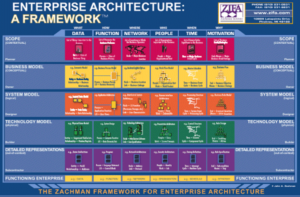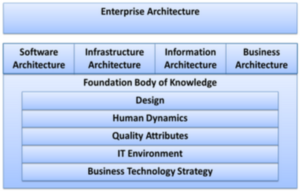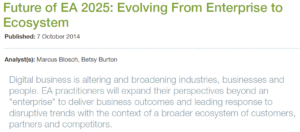If you have been long in this industry, as I have, you may have come across individuals in organisations who have to straddle the worlds of IT and business.
Who is he?
If he speaks the language of business, he most likely has the title “Enterprise Architect” or “IT Architect” or “Digital Architect” on his name card. Or he has an official title that says something else but double hats in roles such as Business Architect, Information/Data Architect, Application/Software Architect, Technology/Infrastructure Architect or Solution Architect, either formally or informally.
Unfortunately, many are given the title of “architect” without understanding the job scope and/or possessing the relevant qualifications, that makes their work many times more difficult to do. Today, with so many organisations pushing for digitalisation everywhere, there has never been a more pressing time for the “architect” to step forward and bring their organisation forward along with them.
Recognising this, IASA, The Global Association for All IT Architects, has been working to formalise the Enterprise Architect’s roles for standards and certifications so that they can be officially recognised as an Enterprise Architecture (EA) profession in the industry with a well-defined and sustainable career path.
History
Although the enterprise architect has been around in the industry for quite some time, it is still relatively new compared to most other professions. As a result, formal and standard definitions and job scopes did not come around for enterprise architecture till much, much later.
Fortunately, John Zachman through his Zachman Frameworks, popularised the terms “Enterprise Architecture Framework” in the early 1990’s among the Enterprise IT adopters. This was followed by The Open Group Architecture Framework (TOGAF) in the mid 1990’s which emphasised the EA Development Methodology.
Then in the late 2000’s IASA introduced the ITABoK (IT Architecture Body of Knowledge) in its efforts to formalise the Enterprise Architect as a profession through skillsets’ requirements delivered as part of training and certification programs.
The following diagrams show the Zachman Framework, TOGAF Framework and IASA’s ITABoK:



In this article, I will focus on the IASA’s ITABoK skillsets that helped to define the competencies’ requirement to become a successful architect with a recognisable and sustainable career path.
The IASA’s five pillars of the ITABoK as described in the above diagram focuses on the five foundational skills areas and it consists of Business Technology Strategy, Human Dynamics, the IT Environment, Quality Attributes and Design.
But, it is business technology strategising that differentiates “architects” from other IT professionals, and serves the all-important purpose of connecting all architects to the business that it serves.
Currently
Enterprise architects have to engage both business and IT, and whatever IT does, it must realise its business strategies. Therefore, the Enterprise Architect should participate and aid in facilitation of the strategic planning committee.
He is also responsible for creating the Digital Enterprise Architecture Map that will facilitate troubleshooting and full traceability of all business and IT efforts that spans the whole enterprise. Above all, needs to close the gap between high-level business strategies through architecture solutioning.
The are 5 EA specialisations – Business Architecture, Information Architecture, Software Architecture, Infrastructure Architecture and Solution Architecture as defined by the IASA’s ITABoK.
The Business Architect focuses on a common, enterprise-level business language and framework for documenting how the business is structured to support a technology strategy within a business strategy. The Information Architect focuses on the management of information resources including storage, retrieval, delivery, classification and utilisation of information to best deliver shareholder values as well as to support technology strategy. The Software Architect focuses on delivering and developing technology strategy related to software and solution implementation. The Infrastructure Architect focuses on the bottom four layers of the Open System Interconnection or OSI seven-layer model and requires skills in operations, network engineering, server sizing, storage management, backup &restore technologies, disaster recovery and physical data centre design. The Solution Architect focuses on delivering solution based on the inputs from Business/Information/Software/Infrastructure Architecture and must have a wide exposure across industries and disciplines so as to be able to realise the architecture through implementation by the PMO (Programme Management Office) as IT projects.
One thing that is for certain however, is that the enterprise architect of today is faced with a job scope that has evolved from being pretty narrow to one that is enterprise-wide, and which includes recent digital technology trends like Big Data Analytics, Internet of Things and Cloud Virtualisation technology.

Gartner predicts that by 2025, the enterprise architect would not only be architecting process, networks and dependencies within the organisation, but outside of his organisation as well, to include the ecosystem.
Moving forward
Now, the context of digitalisation has also added another dimension to the enterprise architect profession, which puts Digital at the center of gravity. The Digital Enterprise Architect is tasked to lead digital transformation in the organisation through Enterprise Architecture efforts.
The role of the Digital Enterprise Architect is more significant now than ever and I do believe that every organisation in any industry, be it an enterprise or government body, needs to have someone if not a team, performing the role of an Enterprise Architect with a domain specialisation of that particular enterprise/government.
In fact, this is the role that is missing from every organisation today that is struggling to survive and be competitive during this quick-paced digital times where we are faced with unpredictable disruptions on a daily basis.
In fact, the urgency to hire architects and establish the EAO (Enterprise Architecture Office) formally within the organisational structure will give that organisation a very strategic advantage to win in this digital era.
The Digital Enterprise Architect is responsible for integrating business and IT by creating the Digital EA Map across multiple layers from the Motivation & Strategic Layer to the Business Layer to the Application Layer to the Technology Layer as well as to the Implementation Migration Layer and vice versa, so that the right portfolio of investment projects can be designed and executed by the PMO through IT projects in a way that makes the best use of IT resources and achieves planned business outcomes.
That is the most compelling reason why I feel that the role of the Enterprise Architect today is very critical beyond just helping to digitalise the organisation – he can also enable traceability, and with it enterprise trouble-shooting capabilities through the Digital Enterprise Architecture Map.
About the Author: Aaron Tan Dani is a thought-leader in Digital EA and he is also actively driving Digital EA adoption and currently he is the Chairman of EA-SIG, Singapore Computer Society aarontan@scs.org.sg, Chairman of Iasa Asia Pacific aarontan@iasahome.org and Chief Architect of ATD Solution aarontan@atdsolution.com







